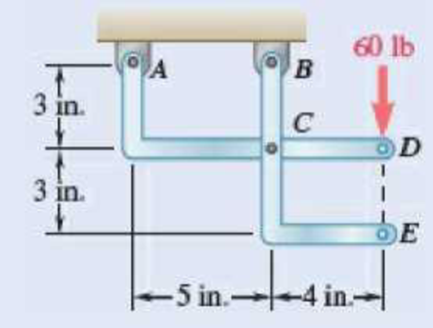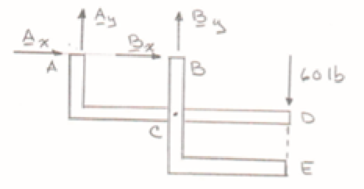
Determine the components of the reactions at A and B, (a) if the 60-lb load is applied as shown, (b) if the 60-lb load is moved along its line of action and is applied at point E.

Fig. P6.87
SOLUTION
Free body: Entire frame:

Analysis is valid for either parts (a) or (b), since position of 60-lb load on its line of action is immaterial.
 ∑MB = 0: − Ay (5 in.) – (60 lb)(4 in.) = 0 Ay = −48 lb
∑MB = 0: − Ay (5 in.) – (60 lb)(4 in.) = 0 Ay = −48 lb
+↑ ∑Fy = 0: By − 60 − 480 = 0 By = +108 lb
 ∑Fx = 0: Ax + Bx = 0 (1)
∑Fx = 0: Ax + Bx = 0 (1)
a) Load applied at D.
Since BCE is a two-force member (with forces applied at B and C only), the reaction at B must be directed along CB. We have, therefore,
Bx = 0
The reaction at B is B = 108.0 lb↑
From Eq. (1): Ax + 0 = 0 Ax = 0
The reaction at A is A = 48.0 lb↓
(b) Load applied at E.
Since ACD is a two-force member, the reaction at A must be directed along AC. We have
From Eq. (1): 80 lb + Bx = 0 Bx = 80 lb
Thus, Bx = 80.0 lb ←, By = 108.0 lb ↑
Want to see the full answer?
Check out a sample textbook solution
Chapter 6 Solutions
VECTOR MECH....F/ENGNRS-STATICS -CONNECT
Additional Engineering Textbook Solutions
Mechanics of Materials (10th Edition)
Fundamentals of Heat and Mass Transfer
Vector Mechanics for Engineers: Statics, 11th Edition
Statics and Mechanics of Materials (5th Edition)
Heat and Mass Transfer: Fundamentals and Applications
Applied Statics and Strength of Materials (6th Edition)
- Can you please do 6.89 Draw the FBD and solve for the problem. Thanksarrow_forwardP A P C HINT: Collar A is in equilibrium 20.5 20 4+₂5 50 lb Free Body: Collar A 150 lb A 20 in. PROBLEM 2.63 Collar A is connected as shown to a 50-lb load and can slide on a frictionless horizontal rod. Determine the magnitude of the force P required to maintain the equilibrium of the collar when (a) x=4.5 in., (b) x=15 in. Where does N come from? What is it?arrow_forward2. A 200-mm lever and a 240-mm pulley are welded to the axel BE that is supported by bearings at C and D. Assume that the bearing at D does not exert any axial thrust. A 720-N vertical force is applied at A when the lever is horizontal. Determine (a) the tension, T, in the cord, and (b) the reactions at C and D. Ans: T = 1200N, C = 400î +1200 N, D=-1600î – 480ĵ N %3D 40 mm 80 mm 120 mm 200 mm D E 120 mm 720 Narrow_forward
- 3. A structure is supported by a roller at point A and pin joint supported at B. The structure is supporting three external loads as shown and the weight of the structure is negligible. Determine: (d) The magnitude of the vertical component of the reaction at point B. 12.5kN 2m A B. 15kN 10kN im Im Im 1m O 0.0 kN 9 7.0 kN O 10.5 kN O 5.0 kNarrow_forwardNiloarrow_forward4.7 When cars C and D stop on a two-lane bridge, the forces exerted by their tires on the bridge are as shown. Determine the total reactions at A and B when (a) a = 2.9 m, (b) a = 8.1 m. -12 m 3.9 kN 6.3 kN| 7.9 kN 7.3 kN C D\B A L-20m-| -2.6 m→ -2.8 marrow_forward
- 2. Determine the reactions at A and B when (a) a = 0, (b) a = 90°, (c) a = 30°. 12 in. 10 in. 10 in. 750 lb in Barrow_forwardQuestion 1 (Type B): A 100 N boom is supported by a pin at A and a cable at C. Determine the magnitudes of the components of the reaction at A and the tension in the cable CD. D 50° 12 kN/m B -3 m 1 marrow_forwardSolve Sample Prob. 4.5, assuming that the spring is unstretched when 0 = 90°.(Reference to Sample Problem 4.5):arrow_forward
- Problem 4.30 4.30 The horizontal force P is applied to the handle of the puller. Determine the resulting tension T and all the other reactions as necessary. P = 120 lb Coplanar system, one rigid body, two supports, one 24 in. external load. B В 40° 20° A -6 in.-arrow_forwardTwo 9-in.-diameter pipes (pipe 1 and pipe 2) are supported every 7.5 ft by a small frame like that shown. Knowing that the combined weight of each pipe and its contents is 30 lb/ft and assuming frictionless surfaces, determine the components of the reactions at A and G.arrow_forwardFundamental Problem 5.9 The rod is supported by smooth journal bearings at A, B, and C and is subjected to the two forces F₁ = 400 N and F2 = 570 N. (Figure 1) Figure 1 0.6 m of 1 0.6 m BF₂ D 0.6 m 0.4 m F₁ Part A Determine the x and y components of reaction at C using scalar notation. Express your answers using three significant figures separated by a comma. V ΑΣΦ ↓↑ vec Cr, Cy= Submit B₂, B₂ = Part B Determine the x and z components of reaction at B using scalar notation. Express your answers using three significant figures separated by a comma. My Answers Give Up Az, Az = Submit VE ΑΣΦ | 11 |¯| ΑΣΦ ↓↑ vec Part C Determine the x and z components of reaction at A using scalar notation. Express your answers using three significant figures separated by a comma. My Answers Give Up ? vec E ? N N Narrow_forward
 Elements Of ElectromagneticsMechanical EngineeringISBN:9780190698614Author:Sadiku, Matthew N. O.Publisher:Oxford University Press
Elements Of ElectromagneticsMechanical EngineeringISBN:9780190698614Author:Sadiku, Matthew N. O.Publisher:Oxford University Press Mechanics of Materials (10th Edition)Mechanical EngineeringISBN:9780134319650Author:Russell C. HibbelerPublisher:PEARSON
Mechanics of Materials (10th Edition)Mechanical EngineeringISBN:9780134319650Author:Russell C. HibbelerPublisher:PEARSON Thermodynamics: An Engineering ApproachMechanical EngineeringISBN:9781259822674Author:Yunus A. Cengel Dr., Michael A. BolesPublisher:McGraw-Hill Education
Thermodynamics: An Engineering ApproachMechanical EngineeringISBN:9781259822674Author:Yunus A. Cengel Dr., Michael A. BolesPublisher:McGraw-Hill Education Control Systems EngineeringMechanical EngineeringISBN:9781118170519Author:Norman S. NisePublisher:WILEY
Control Systems EngineeringMechanical EngineeringISBN:9781118170519Author:Norman S. NisePublisher:WILEY Mechanics of Materials (MindTap Course List)Mechanical EngineeringISBN:9781337093347Author:Barry J. Goodno, James M. GerePublisher:Cengage Learning
Mechanics of Materials (MindTap Course List)Mechanical EngineeringISBN:9781337093347Author:Barry J. Goodno, James M. GerePublisher:Cengage Learning Engineering Mechanics: StaticsMechanical EngineeringISBN:9781118807330Author:James L. Meriam, L. G. Kraige, J. N. BoltonPublisher:WILEY
Engineering Mechanics: StaticsMechanical EngineeringISBN:9781118807330Author:James L. Meriam, L. G. Kraige, J. N. BoltonPublisher:WILEY





